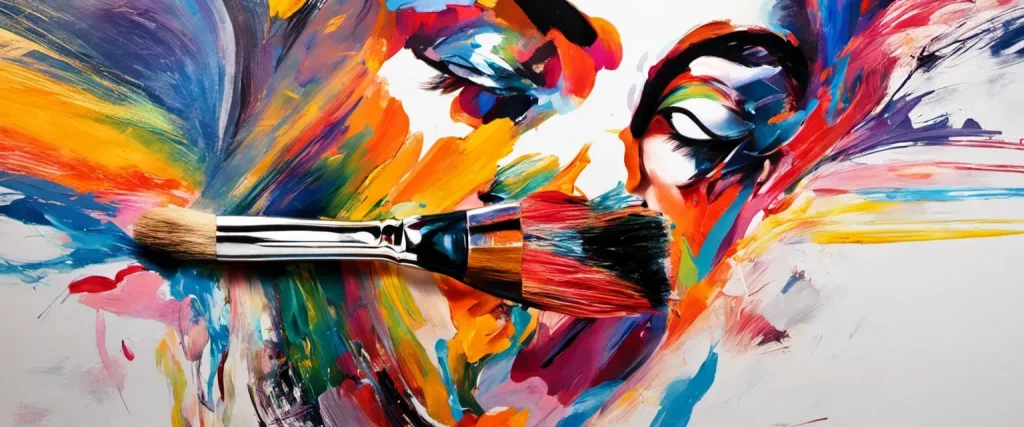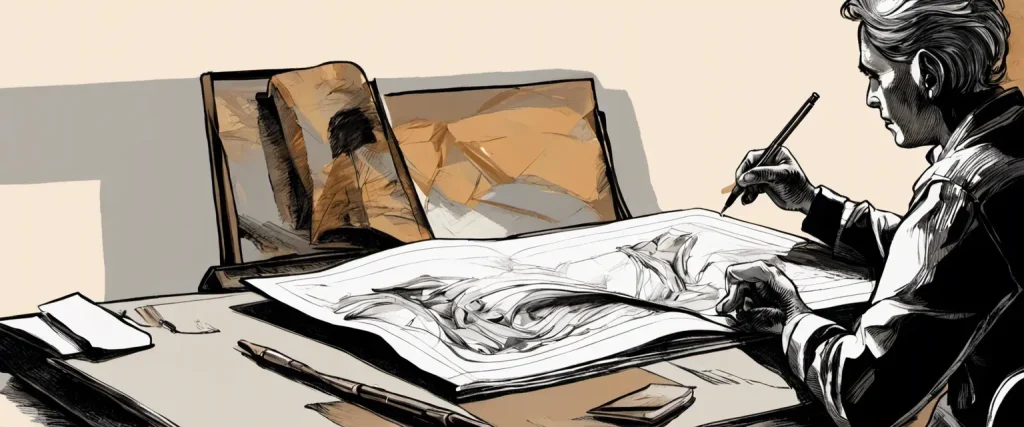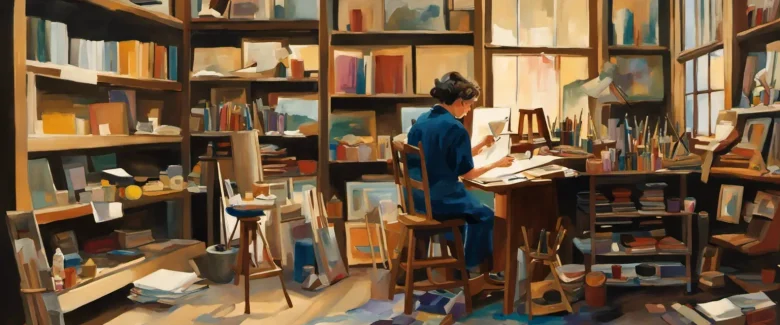“The Artist’s Way” by Julia Cameron is a transformative guidebook designed to unleash the creative potential within each of us. As an accomplished writer, artist, and playwright, Julia Cameron has spent decades honing her creative skills and helping others to do the same. With her extensive knowledge and experience in the arts, she has created a practical and spiritual toolkit to help readers discover and unlock their inner creativity. In this book, Cameron presents a twelve-week program filled with exercises, insights, and personal anecdotes, guiding readers on a journey of self-discovery and artistic self-expression.
Chapter 1: Introduction
Chapter 1: Introduction of “The Artist’s Way” by Julia Cameron provides an overview of the book’s purpose and outlines the main principles and exercises that will help readers unleash their creative potential. Cameron starts by addressing the common belief that creativity is reserved for a select few, asserting that creativity is a vital and innate human quality that can be nurtured and developed by anyone.
She introduces the concept of the “Shadow Artist” – individuals who admire and support artistic endeavors but suppress their own creative aspirations out of fear, doubt, or societal expectations. Cameron aims to guide readers on a journey towards reawakening their artistic spirit and breaking free from creative blocks.
The chapter emphasizes the importance of treating creativity as a sacred practice and making it a priority in one’s life. The author encourages the readers to set aside time for “Artist Dates,” a solitary activity where they can indulge in their creative passions and explore new inspirations.
Cameron also introduces the core tool of the book, called “Morning Pages,” which involves daily writing exercises. The practice requires writing three pages every morning, without any specific goals or audience. This stream-of-consciousness writing helps to clear the mind of negativity, self-doubt, and external pressures, allowing space for creative ideas to flow freely.
Lastly, the author highlights the importance of embracing spirituality, irrespective of one’s religious beliefs, as a means to connect with artistic energy. She suggests developing a sense of trust in the creative process and unlocking the power of positive affirmation.
In conclusion, the opening chapter of “The Artist’s Way” sets the stage for the transformative journey that lies ahead, focusing on the belief that everyone has a creative potential waiting to be discovered and nurtured. By implementing practices such as Morning Pages, Artist Dates, and embracing spirituality, readers can begin to unlock their artistic talents and live a more fulfilled and creative life.
Chapter 2: Recovering a Sense of Identity
Chapter 2: Recovering a Sense of Identity of the book “The Artist’s Way” by Julia Cameron focuses on helping individuals reclaim their creative identities and rediscover their artistic passions. The chapter explores the concept of “shadow artists,” which Cameron describes as individuals who have creative aspirations but have repressed or denied their artistic inclinations.
Cameron asserts that these shadow artists often make careers out of supporting other artists, but neglect their own creative pursuits. This could include working as managers, agents, or even spouses of artists, living vicariously through others rather than pursuing their own artistic dreams.
To recover a sense of identity, Cameron suggests that individuals need to confront their fears and self-doubt that have hindered their artistic expression. She encourages readers to acknowledge their own artistic capabilities and validate their creativity, no matter how small or insignificant it may seem.
Cameron proposes several activities and exercises to help readers reconnect with their creative selves. The key exercise is the “Morning Pages,” where individuals are encouraged to write three pages of stream-of-consciousness thoughts every morning. This exercise aims to clear the mind of negative thoughts, doubts, and fears, allowing space for creativity to bloom.
Another important exercise is what Cameron calls the “Artist’s Date.” She suggests setting aside time each week to engage in activities that bring joy and inspiration, such as visiting a museum, taking a solo nature walk, or exploring a new hobby. This intentional self-care and exploration of one’s interests help create a nurturing environment for artistic growth.
By actively pursuing these exercises, facing fears, and making self-care a priority, individuals can recover their sense of identity as artists and reclaim their creative power. Cameron emphasizes the importance of nurturing the inner artist and embracing the true creative potential within each individual.
Chapter 3: Recovering a Sense of Power
Chapter 3 of “The Artist’s Way” by Julia Cameron is titled “Recovering a Sense of Power” and focuses on exploring our relationship with power and reclaiming it for ourselves as artists. Cameron believes that reestablishing a connection with our personal power is essential for unleashing creativity and embracing our true potential.
The chapter begins by highlighting the importance of recognizing and accepting that we are creative beings. Cameron encourages readers to let go of the belief that creativity is only reserved for those who are deemed “talented” or “gifted.” She argues that creativity is our birthright and that we all possess the potential to create something meaningful.
Cameron introduces the concept of “creative u-turns” as a way to overcome negative beliefs and experiences that may have hindered our creative growth. These u-turns involve acknowledging and addressing past traumas, criticisms, and failures, and reframing them as valuable learning experiences rather than roadblocks. By letting go of self-doubt and embracing self-compassion, we can regain the power to create fearlessly.
The author emphasizes the importance of setting boundaries in order to protect our creativity. Cameron believes that establishing healthy boundaries helps us cultivate a sense of self-worth and protect our time and energy for creative pursuits. She provides practical tools and techniques for setting boundaries, such as identifying toxic relationships or activities that drain our creative energy and learning to say no.
Ultimately, the chapter encourages readers to reclaim their power by acknowledging their creative abilities, developing resilience in the face of adversity, and setting boundaries to protect their creative space. By doing so, individuals can cultivate a strong sense of self-worth and tap into their inherent creative potential.
Chapter 4: Recovering a Sense of Integrity

Chapter 4 of “The Artist’s Way” by Julia Cameron focuses on recovering a sense of integrity. Cameron explains that integrity is essential for artists because it helps them align their actions with their true desires and values, both in their art and in their lives.
The chapter begins by emphasizing the importance of staying true to oneself and following one’s creative instincts. It highlights the need to remove toxic influences and negative beliefs that hinder creative growth. Cameron encourages artists to let go of shame and fear that may have been instilled in them by society, and instead, listen to their inner voice and follow their own unique path.
To recover a sense of integrity, the author introduces the concept of “morning pages” – a daily practice of writing three pages of stream-of-consciousness thoughts every morning. This process helps artists connect with their true desires and uncovers any hidden fears or obstacles that may be holding them back. The aim is to release negative thoughts and emotions, making room for fresh ideas and creative inspiration.
Cameron also advocates for artist dates, a weekly solo outing where the artist engages in something enjoyable and nurturing to their creative spirit. This practice helps artists reconnect with their passions and reminds them of their commitment to their art.
Overall, Chapter 4 emphasizes the importance of nurturing one’s creative self and ignoring societal expectations. It guides artists towards a more authentic and fulfilling creative journey by encouraging them to let go of judgment, practice self-care, and stay committed to their creativity.
Chapter 5: Recovering a Sense of Possibility
Chapter 5: Recovering a Sense of Possibility of the book “The Artist’s Way” by Julia Cameron delves into the importance of nurturing our sense of possibility in order to reignite our creativity and spiritual growth. In this chapter, Cameron focuses on unblocking our inner sense of hope and potential, which often gets diminished as we face life’s challenges and setbacks.
The chapter begins by exploring the concept of abundance, emphasizing that the universe is abundant and available to support our creative endeavors if we are willing to believe in and embrace this abundance. Cameron encourages readers to confront and challenge their limiting beliefs and negative self-talk that may hinder their sense of possibility. She suggests that by recognizing and changing our negative thought patterns, we can open ourselves up to attracting positive experiences and opportunities.
Cameron introduces the use of affirmations as a tool to rewire our thought patterns. By repeatedly affirming positive statements about ourselves and our creative abilities, we can gradually shift our mindset towards one of possibility and abundance. She also stresses the importance of nurturing our inner child, acknowledging that childishness (not to be confused with immaturity) fosters a sense of wonder, playfulness, and curiosity, which are vital for creative growth.
Throughout the chapter, Cameron emphasizes the significance of taking small steps towards our creative goals. She encourages readers to engage in creative exercises and activities regularly, without attachment to the outcome, as a means of reconnecting with their artistic instincts. By embracing the process instead of fixating on results, we can restore our sense of possibility and creativity in a more joyful and organic manner.
In summary, Chapter 5 of “The Artist’s Way” highlights the importance of embracing abundance, challenging limiting beliefs, using affirmations, nurturing our inner child, and taking small steps towards our creative goals. By doing so, we can recover a sense of possibility, reignite our creative potential, and foster personal growth.
Chapter 6: Recovering a Sense of Abundance
Chapter 6: Recovering a Sense of Abundance, from the book “The Artist’s Way” by Julia Cameron, delves into overcoming scarcity and embracing abundance in our lives to fuel our creativity.
The chapter opens by highlighting the concept of synchronicity, which refers to meaningful coincidences that seem to be orchestrated by a higher power. Cameron emphasizes that as we align ourselves with our creative selves, synchronicities become more frequent in our lives. She encourages readers to trust in this higher order and see these occurrences as signs of abundance.
Cameron discusses the importance of gratitude in cultivating abundance. She suggests cultivating a sense of gratitude through morning pages, affirmations, and setting intention for positive experiences. By acknowledging and appreciating what we already have, we invite more abundance into our lives.
The author also addresses the role of money in the creative process and dispels the myth of the “starving artist.” She encourages readers to let go of any negative beliefs they may hold about money and creativity, and instead embrace the idea that we can be successful and prosper through our artistic pursuits.
In this chapter, Cameron presents various tools and exercises to support the recovery of abundance. The key practice is called “Counting,” where one records small moments of beauty, abundance, and joy experienced throughout the day. This exercise helps shift our mindset from scarcity to abundance, reminding us of the abundance that already exists in our lives.
By recovering a sense of abundance, we create an environment that nourishes our creativity. This chapter aims to break down limiting beliefs and allows us to fully embrace the richness of our lives, enabling us to tap into our creative potential and continue our artistic journey with a sense of fulfillment and joy.
Chapter 7: Recovering a Sense of Connection
In Chapter 7 of “The Artist’s Way” by Julia Cameron, titled “Recovering a Sense of Connection,” the author focuses on helping readers reestablish authentic connections with others and reclaim their creativity. Cameron believes that creativity thrives in collaborative and supportive environments, and this chapter offers various exercises to strengthen these connections.
The chapter starts by emphasizing the importance of initiating conversations with others to create a network of creative support. By reaching out and engaging in shared interests, readers can foster alliances that promote growth and inspiration. Cameron encourages readers to utilize the principle of synchronicity, where meaningful coincidences and connections arise when one is open to them. By nurturing these connections, individuals can gradually overcome fears, self-doubt, and isolation, which may hinder their artistic endeavors.
Additionally, Cameron introduces the concept of “dark alliances,” toxic relationships that drain creative energy, and suggests ways to identify and distance oneself from such negative influences. By doing so, artists can make room for positive relationships that uplift and nourish their creative spirit.
The chapter also explores the idea of “creative u-turns,” a process of forgiving and renegotiating past hurts or unfulfilled dreams. This exercise allows readers to release resentments and reconnect with their creativity from a space of healing. By forgiving others and themselves, artists can open up space for new opportunities and embrace their creative journey more fully.
Overall, Chapter 7 seeks to cultivate a sense of connection, collaboration, and authenticity in artists’ lives. Through establishing supportive connections, addressing past hurts, and adopting a mindset of forgiveness, individuals can recover their creative energy and immerse themselves in the joy of artistic expression.

Chapter 8: Recovering a Sense of Strength
Chapter 8 of “The Artist’s Way” by Julia Cameron is titled “Recovering a Sense of Strength.” This chapter dives into the concept of power and how it affects an artist’s creative process. Cameron emphasizes the importance of taking care of oneself and building inner strength to overcome obstacles and creative blocks.
Cameron begins the chapter by discussing the common fear that artists often face: the fear of rejection. She explains that this fear is natural, but it must not hold the artist back from expressing themselves. By acknowledging this fear and facing it head-on, artists can reclaim their power and regain confidence in their abilities.
The chapter also introduces the concept of synchronicity, defined as the alignment of meaningful events that seem to occur by chance. Cameron encourages artists to be open to these synchronicities as they can lead to unexpected opportunities and connections that foster creativity.
To recover a sense of strength, Cameron suggests various tools and practices. She emphasizes the importance of establishing a solid foundation through self-care, such as maintaining physical health, getting enough sleep, and practicing mindfulness. The author recommends taking breaks from the constant busyness of daily life to rejuvenate and allow new ideas to emerge.
Cameron also emphasizes the significance of setting boundaries. Artists need to protect their energy and creative space from distractions or people who drain their creativity. She advises creating clear boundaries around creative time and establishing rules to maintain focus and avoid outside interference.
In summary, Chapter 8 of “The Artist’s Way” focuses on the recovery of strength and power as essential elements for an artist’s creative journey. Through self-care, setting boundaries, and embracing synchronicity, artists can reclaim their confidence, overcome fear, and embark on a more fulfilling artistic path.
After Reading
In conclusion, “The Artist’s Way” by Julia Cameron is a compelling guidebook for artists and creatives seeking to unleash their true potential. Cameron introduces practical techniques and insightful exercises that can help readers release their creative blocks, nurture their inner artist, and discover a more fulfilling and authentic creative life. By emphasizing self-expression, self-discovery, and self-care, Cameron provides a roadmap for individuals to reclaim their creative power, overcome obstacles, and cultivate a consistent creative practice. This book offers invaluable tools and inspiration for anyone wanting to tap into their artistic capabilities and live a more fulfilling and enriched life.
1. “The Creative Habit” by Twyla Tharp – In this wonderfully insightful book, renowned choreographer Twyla Tharp explores the routines and rituals that can help cultivate creativity. Drawing from her own experiences and those of other artists, Tharp offers practical advice, exercises, and anecdotes that will inspire anyone looking to harness their artistic potential.
2. “Steal Like an Artist” by Austin Kleon – Austin Kleon’s book is a refreshing take on sparking creativity. By exploring the idea of embracing influence, stealing ideas, and remixing them into something unique, he encourages artists of all disciplines to dive into their work fearlessly. The book is filled with quirky illustrations and engaging anecdotes that make it an entertaining and thought-provoking read.
3. “The Elements of Style” by William Strunk Jr. and E.B. White – This classic guide to writing is a must-have for any aspiring writer. Strunk and White focus on the essentials of clear and concise writing, providing helpful tips and rules that can transform your writing style. Whether you’re a professional writer or just starting out, this book will help you develop a strong foundation in the art of writing.
4. “The Creative License” by Danny Gregory – In this inspiring book, Danny Gregory explores the importance of allowing ourselves the freedom to express our artistic impulses. Through personal anecdotes and practical exercises, he encourages readers to embrace their inner artist and break free from self-doubt and creative blocks. Gregory’s warm and relatable writing style makes this book a valuable companion for anyone seeking to unlock their creative potential.
5. On Writing” by Stephen King – Part memoir, part writing manual, Stephen King’s “On Writing” is a captivating exploration of the craft from a master storyteller. King shares his personal journey as a writer, offering valuable insights and practical advice on everything from plotting and character development to finding your unique voice. This book is a captivating read for aspiring writers and a fascinating glimpse into the mind of a literary icon.



